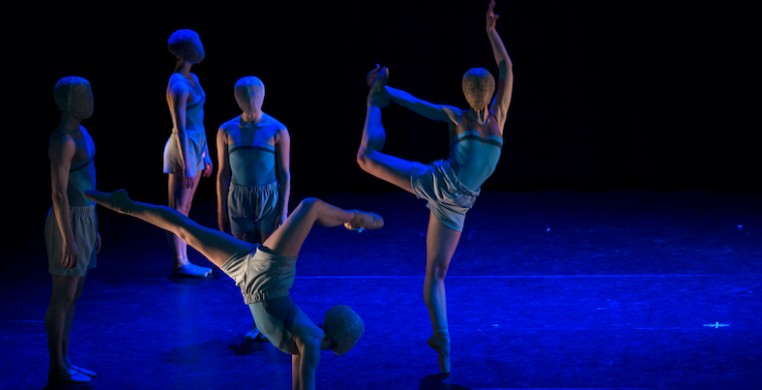On the surface, Ballet 5:8 looks like just another dance company. But the creative impulse of artistic director and chief choreographer Julianna Rubio Slager is driven by her Christian faith and a desire to share the gospel through ballet.
Now, Christian dance companies are not new or particularly unusual, but one of this caliber is. Slager is an ambitious director who, with a robust team of supporters and administrators, has capitalized on her location in the less artistically-saturated suburbs to build what I predict will be an enduring organization. And when Ballet 5:8 ventures into the city once or twice a year—as with Saturday’s one-night-only performance at the Studebaker Theatre—Chicago audiences are reminded of their growing presence in the region’s dance landscape.
The biggest problem with “Butterfly”—a long program of mixed rep with a one-act narrative ballet of the same name—was the Studebaker itself. Despite a gorgeous renovation that brought the historic theater back up to snuff in 2016, certain aspects remain awkward or unfinished. Don’t get me wrong: that the Studebaker is back in commission is a good thing, and fills a much-needed gap in theaters in the 500-1,000 seat range. But, for example, startling house lights come on and off like a too-bright bathroom fixture in the morning. There’s no front light, the sight lines are not ideal, and the sound equipment is sub-par, on a good day.
Not that any of that is Ballet 5:8’s fault, but these details pecked at the quality of what is an otherwise polished performance. These are capable dancers who are being pushed hard, to their credit—qualities most clearly evidenced by the first and third pieces on the program, both by Slager.
“Brothers & Sisters” opens the evening, a cute, plotless, Robbins-eque ballet for nine dancers decked out in knee socks and tennis garb. The concept is simple: men and women. “The Creator must have moved with delight as he drew his children with contrasting and complementary strokes,” wrote Slager in her program notes. Indeed, this is a carefree, playful romp set up in three groups of three, each trio with one of the company's three men, all organized by the color of their costumes. It isn’t child-like the whole way through, though large sections of this piece offer images of recess games and cloud gazing. Watching the piece, this writer imagined the transitions that take place as day becomes night, or as childhood evolves into adulthood as those glee-filled leaps, skips and turns became more studied pas de deux and pas de trois.
Coming third, “Of Splendors & Horrors” is derived from a text by C.S. Lewis, a frequent source of inspiration for Slager. A mechanical-sounding electronic score by Jon Hopkins matches the futuristic vibe in Slager’s contemporary technique, Annika Grasman’s lighting and Lorianne Barclay’s streamlined pale blue leotards and shorts. Barclay, a dancer in all four pieces on the program, gives herself and the rest of this cast a significant challenge, with mesh masks obscuring their facial features. It’s a dramatic visual, rewarding for us, but perhaps messes with the dancers’ perception and causes them to be overly cautious in what can and should be a rip-roaring piece. The implication is from Lewis’ “The Weight of Glory,” in which the author talks about gods and goddesses who walk among us, though I’m not sure the artistic benefits of those masks outweigh the risk.
Between these two is Kevin Jenkins’ “Still Waters,” a meditation on Psalm 23 for the full company, dressed in soft beige hues with red accents. Jenkins paints the stage with a steady hand, carving beautiful patterns accented with scrupulous gestures and arm motions. “Still Waters” is pretty, if too careful, held back slightly by its solo piano score that fails to infuse the piece with peaks and valleys to keep it interesting.
The main event is Ballet 5:8’s newest one-act ballet called “Butterfly,” which uses the true story of Friedl Dicker-Brandeis as a jumping off point for a narrative work about Terezin, a World War II ghetto in former Czechoslovakia. This story ballet is strongest when Slager uses dancing to drive the plot forward. Her talent lies in creating deeply emotional and evocative movement than in more literal references and theatrical pantomime. “Butterfly’s” stunning groups sections and a handful of pas de deux, in fact, do the heavy lifting in portraying the despair and horrors of the Holocaust.
It is not all sadness, however. Slager draws from Dicker-Brandeis’ spirit—the art teacher, whose secret instruction of children in the ghetto is considered among the origins of expressive art therapies, died in Auschwitz—to create a sense of optimism and hope amongst the cast. That, I was not expecting, nor was I expecting to enjoy a balletic treatment of this weighty topic. Ballet 5:8, after all, is not just another dance company.


